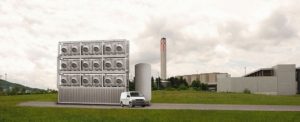Source: collective-evolution.com
Published: June 3, 2016

Gases that help capture heat, called “greenhouse gases,” can be emitted from natural sources, while others are anthropogenic, resulting from human activities. The latter has caused a surge in global warming that has wreaked havoc on the wellbeing of our planet, and will continue to do so if we don’t change our practices drastically. In fact, a new study suggests that we could prevent up to 3 million premature deaths annually by the year 2100 if we reduced our emissions.
Many strategies for reducing greenhouse gas emissions have been developed over the last few years, with the majority involving ways to pump less carbon into the air, but what about the greenhouse gases already suffocating the atmosphere?
Swiss company Climeworks has developed carbon capture and storage technology which will suck carbon pollution directly out of the air around us through the world’s first commercial carbon capture plant. They are set to begin operating in September or October of this year out of a newly-built facility near Zurich. The pilot plant will draw and filter CO2 out of ambient air as well as repurpose the gas as a marketable product.
Climeworks will try to sell its CO2 to third parties for use in agricultural processes like growing vegetables, and has considered other partnerships including beverage makers, who would be able to use it to carbonate their drinks.
The direct air capture process Climeworks will use entails collector modules sucking air into a sponge-like filter treated with chemicals acquired from ammonia. As New Scientist explains, “once the filter is saturated, the gas will be released by warming it with the heat generated by a nearby municipal waste incineration plant, then piped to a 4 hectare greenhouse.”
Climeworks aims to extract between 2 and 3 tonnes of CO2 daily, which is about 200 cars annually, but this barely scratches the surface of the roughly 40 billion tonnes of carbon put into the atmosphere each year by human activity. Because of this, the new strategy will only make an impact if it is widely implemented.
“The advantage of taking it out of the ambient air is that you can do it wherever you are on the planet,” Climeworks’ chief operating officer Dominique Kronenberg explained. “You don’t depend on a C02 source, so you don’t have high costs transporting it where it is needed.”
Another setback is the price, which is around US$600 per tonne — not an inexpensive solution to reducing CO2 in the atmosphere.
“I think it provides false hope,” engineer Howard Herzog from MIT’s Energy Initiative said. “Why should we expect future generations to adopt significantly more expensive measures to deal with C02?”
Yet despite the skeptics, this focus on direct air capture plants marks a step in the right direction, and the technology has gained a lot of interest. In fact, Canada’s Carbon Engineering and New York-based Global Thermostat are also working on implementing this technology.
“While there is no one silver bullet technology to end climate change, using direct air capture to make fuels is potentially scalable, in a way that biofuels aren’t, because it doesn’t use much land or other resources,” explained Carbon Engineering founder David Keith.
In the meantime, let’s just hope this ambitious technology works to reduce CO2 emissions and aids the world carbon reduction efforts.
